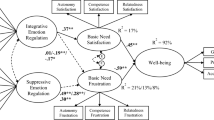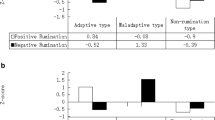Abstract
Emotional rumination and inhibition were identified in the Emotion Control Questionnaire (ECQ—Roger and Nesshoever 1987; Roger and Najarian 1989) as two relatively independent dimensions of emotional style, and the two measures have subsequently been shown to be important moderator variables in a range of health and forensic settings. Two other dimensions that emerged in the ECQ, labelled aggression control and benign control, have been shown to form part of the extraversion constellation, and the present paper describes the construction and validation of a new scale focusing exclusively on rumination and inhibition. Revised and expanded item pools for the scales were subjected to exploratory and confirmatory factor analyses, which endorsed the two-factor structure. The new scales were validated concurrently against related scales in different samples, and were shown to be systematically related to two independent indices of health status.
Similar content being viewed by others
References
Alhija, F. N., & Wisenbaker, J. (2006). A Monte Carlo study investigating the impact of item parceling strategies on parameter estimates and their standard errors in CFA. Structural Equation Modelling, 13, 204–228.
Beck, A. T., Steer, R. A., & Brown, G. (1996). Beck depression inventory (2nd ed.). San Antonio: The Psychological Corporation.
Bentler, P. M. (1990). Comparative fit indexes in structural models. Psychological Bulletin, 107, 238–246.
Bentler, P. M. (1995). EQS structural equations program manual. Encino: Multivariate Software, Inc.
Bentler, P. M., & Bonett, D. G. (1980). Significance tests and goodness of fit in the analysis of covariance structures. Psychological Bulletin, 88, 588–606.
Bentler, P. M., & Chou, C. P. (1987). Practical issues in structural equation modeling. Sociological Methods and Research, 16, 78–117.
Browne, M. W., & Cudeck, R. (1993). Alternative ways of assessing model fit. In K. A. Bollen & J. S. Long (Eds.), Testing structural equation models (pp. 136–162). Newbury Park: Sage.
Chou, C.-P., & Bentler, P. M. (1995). Estimation and tests in structural equation modeling. In R. H. Hoyle (Ed.), Structural equation modeling: Concepts, issues, and applications (pp. 37–55). Thousand Oaks: Sage.
Cohen, S., & Hoberman, G. S. (1983). Positive events and social support as buffers of life change stress. Journal of Applied Social Psychology, 13, 99–125.
Conway, M., Csank, P. A. R., Holm, S. L., & Blake, C. K. (2000). On individual differences in rumination on sadness. Journal of Personality Assessment, 75, 404–425.
Denollet, J., Sys, S. U., Stroobant, N., Rombouts, H., Gillebert, T. C., & Brutsaert, D. L. (1996). Personality as independent predictor of long-term mortality in patients with coronary heart disease. Lancet, 347, 417–421.
Endler, N. S., & Parker, D. A. (1990). Multidimensional assessment of coping: a critical evaluation. Journal of Personality and Social Psychology, 58, 844–854.
Floyd, F. B., & Widaman, K. F. (1995). Factor analysis in the development and refinement of clinical assessment instruments. Psychological Assessment, 7, 286–299.
Forbes, A., & Roger, D. (1999). Stress, social support and fear of disclosure. British Journal of Health Psychology, 4, 165–179.
Guarino, L. (2003). Emotional sensitivity: A new measure of emotional lability and its moderating role in the stress-illness relationship. Unpublished D.Phil. dissertation, University of York.
Guarino, L., Roger, D., & Olason, D. (2007). Reconstructing N: a new approach to measuring emotional sensitivity. Current Psychology, 26, 37–45.
Harris, P. W., Pepper, C. M., & Maack, D. J. (2008). The relationship between maladaptive perfectionism and depressive symptoms: the mediating role of rumination. Personality and Individual Differences, 44, 150–160.
Hoyle, R. H., & Panter, A. T. (1995). Writing about structural equation models in structural equation modeling. In R. H. Hoyle (Ed.), Structural equation modeling: Concepts, issues, and applications (pp. 158–176). Thousand Oaks: Sage.
Hu, L.-T., & Bentler, P. (1995). Evaluating model fit. In R. H. Hoyle (Ed.), Structural equation modeling. Concepts, issues, and applications (pp. 76–99). Thousand Oaks: Sage.
Jöreskog, K. G., & Sörbom, D. (1989). Lisrel 7: A guide to the programme and application. Chicago: SPSS.
Kaiser, J., Hinton, J. W., Krohne, H. W., Stewart, R., & Burton, R. (1995). Coping dispositions and physiological recovery from a speech preparation stressor. Personality and Individual Differences, 19, 1–11.
Kishton, B. M., & Widaman, K. F. (1994). Unidimensional versus domain representative parcelling of questionnaire items: An empirical example. Educational and Psychological Measurement, 54, 757–765.
Lyne, K., & Roger, D. (2000). A psychometric re-assessment of the COPE questionnaire. Personality and Individual Differences, 29, 321–335.
McDougall, C., Venables, P., & Roger, D. (1991). Aggression, anger control and emotion control. Personality and Individual Differences, 12, 625–629.
Meadows, M. (1989). Personality, stress and health. Unpublished D.Phil. dissertation, University of York.
Nieland, M., & Roger, D. (1993). Emotion control and analgesia in labour. Personality and Individual Differences, 14, 841–844.
Nolen-Hoeksema, S., & Morrow, J. (1991). A prospective study of depression and distress following a natural disaster: the 1989 Loma Prieta earthquake. Journal of Personality and Social Psychology, 61, 105–121.
Nolen-Hoeksema, S., Parker, L. E., & Larson, J. (1994). Ruminative coping with depressed mood following loss. Journal of Personality and Social Psychology, 67, 92–104.
Papageorgiou, C., & Wells, A. (1999). Process and meta cogniyive dimensions of depressive and anxious thoughts and relationships with emotional intensity. Clinical Psychology & Psychotherapy, 6, 152–162.
Pennebaker, J. W., Colder, M., & Sharp, L. K. (1990). Accelerating the coping process. Journal of Personality and Social Psychology, 58, 528–537.
Petrie, K. J., Booth, R., & Pennebaker, J. W. (1998). The immunological effects of thought suppression. Journal of Personality and Social Psychology, 75, 1264–1272.
Raykov, T. (1998). Coefficient alpha and composite reliability with interrelated nonhomogeneous items. Applied Psychological Measurement, 22, 375–385.
Roger, D. (1995). Emotion control, coping strategies and adaptive behavior. Stress and Emotion, 15, 255–264.
Roger, D. (1996). The role of cognitive rumination, copying styles and self-esteem in moderating adaptational responses to stress. Paper presented at the 8th European Conference on Personality, University of Ghent, July.
Roger, D. (1999). The role of cognitive rumination, coping styles and self-esteem in moderating adaptational responses to stress. In I. J. Deary, F. de Fruyt, & F. Ostendorf (Eds.), Personality psychology in Europe, Volume 7 (pp. 351–364). Tilburg: Tilburg University Press.
Roger, D., & Nesshoever, W. (1987). The construction and preliminary validation of a scale for measuring emotional control. Personality and Individual Differences, 8, 527–534.
Roger, D., & Jamieson, J. (1988). Individual differences in delayed heart-rate recovery following stress: the role of extraversion, neuroticism and emotional control. Personality and Individual Differences, 9, 721–726.
Roger, D., & Najarian, B. (1989). The construction and validation of a new scale for measuring emotional control. Personality and Individual Differences, 10, 845–853.
Roger, D., & Masters, R. (1997). The development and evaluation of an emotion control training programme for sex offenders. Legal and Criminological Psychology, 2, 51–64.
Roger, D., & Najarian, B. (1998). The relationship between emotional rumination and cortisol secretion under stress. Personality and Individual Differences, 24, 531–538.
Roger, D., Jarvis, G., & Najarian, B. (1993). Detachment and coping: the construction and validation of a new scale for measuring coping strategies. Personality and Individual Differences, 15, 619–626.
Roger, D., Najarian, B., & Nash, P. (1996). The interactive effects of self-esteem, cognitive rumination and coping styles in moderating the relationship between stress and illness. Paper presented at the British Psychological Society Health Psychology Annual Conference, University of York, July.
Siegle, G. J., Moore, P. M., & Thase, M. E. (2004). Rumination: one construct, many features in healthy individuals, depressed individuals, and individuals with Lupus. Cognitive Therapy and Research, 28, 645–668.
Shevlin, M. E., Miles, J. N. V., & Lewis, C. A. (2000). Comments on ‘Confirmatory factor analysis of the Multidimensional Students’ Life Satisfaction Scale’. Personality and Individual Differences, 28, 187–190.
Thomsen, D. K., Mehlsen, M. Y., Hokland, M., Viidik, A., Olesen, F., Avlund, K., et al. (2004). Negative thoughts and health: associations among rumination, immunity, and health care utilization in a young and elderly sample. Psychosomatic Medicine, 66, 363–371.
Thomsen, D. K., Mehlsen, M. Y., Olesen, F., Hokland, M., Viidik, A., Avlund, K., et al. (2004). Is there an association between rumination and self-reported physical health? Journal of Behavioral Medicine, 27, 215–231.
Treynor, W., Gonzalez, R., & Nolen-Hoeksema, S. (2003). Rumination reconsidered: a psychometric analysis. Cognitive Therapy and Research, 27, 247–259.
Author information
Authors and Affiliations
Corresponding author
Rights and permissions
About this article
Cite this article
Roger, D., de Scremin, L.G., Borril, J. et al. Rumination, Inhibition and Stress: The Construction of A New Scale for Assessing Emotional Style. Curr Psychol 30, 234–244 (2011). https://doi.org/10.1007/s12144-011-9117-y
Published:
Issue Date:
DOI: https://doi.org/10.1007/s12144-011-9117-y




